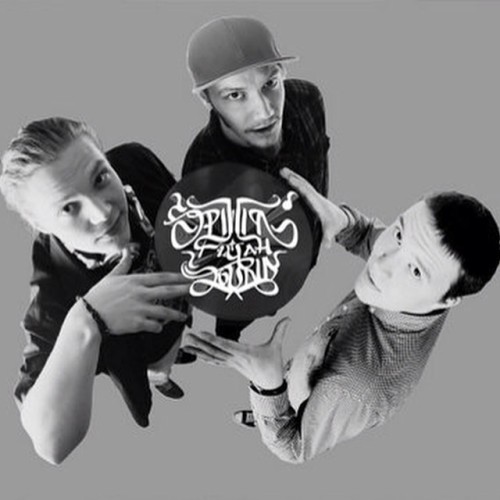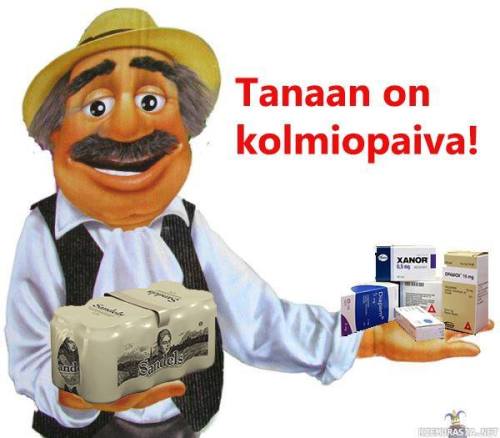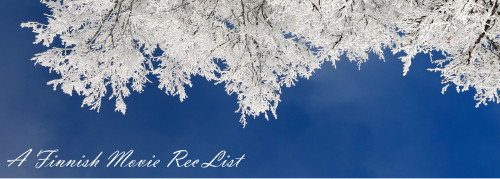#finnish
In Finnish, we don’t “I’ll go out even if it rained cats and dogs”, we rarely use the old saying “Menen ulos vaikka sataisi ämmiä äkeet selässä” which literally means “I’ll go out even if it rained bitches/hags with harrows on their backs”.
Just another Finnish linguistic badassery.
Submitted by @decaffeinated, with the help of @neeleys,@bling-a-ling,@artniila,@holayshiteand@rragnaroks
[resources:Wiktionary,Urbaani Sanakirja (in Finnish)andSynonyymit.fi (in Finnish)]
In Finnish we don’t say “dragon” we say “lohikäärme” which roughly translates to “salmon snake” and I think that’s beautiful.
Submitted by @noasadventures, with the help of @rragnaroksand@neeleys
[resource:Wiktionary,Wikipedia (in Finnish),Sanakirja.fiandWikisanakirja (in Finnish)]
Pet peeve strikes again.
Yes, it does sound like salmon snake to a modern speaker, but etymologically it’s something completely different: it’s an old loan from Old Swedish, floghdrake, that means a flying snake. Finns couldn’t pronounce the many consonants at the beginning of the word, so it changed in their mouths into lohi that sounds quite similar and happens to mean salmon. Käärme is a direct translation of the word drake, snake.
I’ve made a couple of posts about this, and will continue to do so as long as I see these translations going around. This is why language is so interesting.
In Finnish we don’t say “dragon” we say “lohikäärme” which roughly translates to “salmon snake” and I think that’s beautiful.
Submitted by @noasadventures, with the help of @rragnaroksand@neeleys
[resources:Wiktionary,Wikipedia (in Finnish),Sanakirja.fiandWikisanakirja (in Finnish)]
Random finnish nonsense time:
et = you don’t
ette = you don’t (plural)
ettette = so that you (plural) will not
tee = tea
tee = to do
teet = you do
teette = you (plural) do
teettää = to make someone do something on your behalf
teetä = the previous, but in imperative - when you’re telling someone to make someone else do something on their behalf
teetä = tea, but as the object of the sentence
ettette teetä teetä = so that you will not make someone make y'all tea
teet = different types of teas
teettä = without tea
teitä = you (plural, accusative)
teitä = different types of teas (partitive, as the object of the sentence)
teitä = roads (partitive, object)
teille = to/for you (plural)
teille = to/for different kinds of teas
teille = to/for roads
teetättää = to have something be done on your behalf, but perhaps via a middleman
teetätä = the previous, in imperative
teetättäkää = the previous, but plural
teetättäkää teille teitä ettette tee teitä teettä = have types of teas made for you on your behalf so that you won’t be making roads without tea
Languages of Europe
Finnish (Suomen kieli)
Basic facts
- Number of native speakers: 4,994,490 including 4,700,000 in Finland
- Official language: Finland, European Union (EU)
- Minority language: Sweden, Karelia (Russia)
- Language of diaspora: Canada, Estonia, Norway, Russia, Sweden, United States
- Alphabet:Latin, 29 letters
- Grammarical cases: 15
- Linguistic typology: agglutinative, compounding, vowel harmony, pro-drop, SVO
- Language family: Uralic, Finno-Ugric
- Number of dialects: 3 dialect groups
- Longest word: epäjärjestelmällistyttämättömyydelläänsäkäänköhän (not even by her lack of organization, do you suppose) - 53 letters
History
- 1500-1000 BCE - Finnic languages evolved from the Proto-Finnic language after Sámi was separated from it
- 13th century - first known document in any Finnic language
- c. 1450 - first known written example of Finnish
- 16th century - first comprehensive writing system for Finnish
- 1853 - first Swedish-Finnish dictionary
- 1870 - first novel written in Finnish
- 1880 - first Finnish-Swedish dictionary
Many people suppose that Finnish and related languages are “Scandinavian". In fact, Finnish is not genetically related to Swedish or Norwegian. The only major European languages which have common ancestry with FinnishareEstonian and Hungarian.
Writing system and pronunciation
These are the letters that make up the alphabet: a b c d e f g h i j k l m n o p q r s t u w v x y z å ä ö.
Finnish uses the basic Latin alphabet with three diacritics: ä, ö and å. Ä and ö are quite common, whereas å is only used in Swedish loanwords.
The language makes a distinction between long and short sounds. This is quite important to remember since a mistake in vowel or consonant length can alter the meaning of a word. For example, one should be clear whether what they mean is “recession” (lama) or “llama” (laama).
Thestress in Finnish is on the first syllable. It is a language where the basic rule is “say it the way you write it”.
Grammar
An interesting feature of Finnish is the number of grammatical cases. Depending on the approach, 14 to 17 cases are said to operate in Finnish. Six of them are locative cases: they convey the meaning of movement to a place, being in a place and moving away from a place. In Finnish, it is important to distinguish between inner and outer locative cases.
The Finnish language is famous for its inventory of onomatopoetic words. Words that represent sounds differ according to who or what makes them.
Dialects
There are three main groups of dialects: theNorthern, Eastern and Western dialects. Compared to other European languages, the dialectal divisions of Finnish are quite large. The main division between the dialects is that between Eastern and Western dialects. Dialect differences mainly concern phonetics and phonology, but there are also some interesting lexical differences.
Northern dialects include the Middle and North Ostrobothnia (keski- ja pohjoispohjalaiset murteet) spoken in Central and Northern Ostrobothnia and the Far Northern dialects(peräpohjalaiset murteet) spoken in Lapland.
The Eastern dialects consist of the Savonian dialects (savolaismurteet) spoken in Savo and the South-Eastern dialects(kaakkoismurteet), previously spoken on the Karelian Isthmus and in Ingria, which were evacuated during the Second World War.
Western dialects include Southwestern dialects(lounaismurteet) spoken in Southwest Finland and Satakunta, the Tavastian dialects(hämäläismurteet) spoken in Tavastia, and the Southern Ostrobothnia dialects(eteläpohjalaiset murteet) spoken in Southern Ostrobothnia.
Hyvää joulua, @lily-learns-finnish !!! ♡ I was your secret santa for @langblrsecretsanta this year. I got a bit carried away and made you more than one gift, hope you don’t mind. Here’s the first one, it’s a movie rec list of Finnish movies, most of which I have actually seen (I admit I don’t watch a ton of Finnish stuff despite living in Finland). Perhaps you’ve seen some of these but I think watching movies in one’s target language is always good practice since the language in them is much closer to actual spoken language than what you see in text books or literature. Don’t know how easy it’d be to find these movies online but if you’re in Finland I’m sure most libraries have at least some of them.
comedy/drama
“After a man called Janne living in Lapland in Northern Finland fails to acquire a digital television adapter for his wife from the local utility store due to not reaching it before closure time, he sets out with his two friends in the middle of the night to get one by any means necessary. He sets up a late rendezvous with his father-in-law who owns an electronics store in Rovaniemi, several hundred kilometers away. Nothing is naturally ever simple and along the way, the trio end up having several comedic misadventures”
- Korkein oikeus (Inner Trial) (2008) (x)
“Noa is a young slacker who prefers to spend his days smoking weed. Together with his friends, he meets an old hippie, who is interested in rekindling his past passion of psychedelic trips and mind expansion.”
“A cancer patient meets a new friend at the hospital, and together they escape on the adveture of their lives.”
- Hevi reissu (Heavy Trip) (2018) (x)
“In this offbeat comedy from Finland, Turo is stuck in a small village where the best thing in his life is being the lead vocalist for the amateur metal band Impaled Rektum. The only problem? He and his bandmates have practiced for 12 years without playing a single gig. The guys get a surprise visitor from Norway–the promoter for a huge heavy metal music festival–and decide it’s now or never. They steal a van, a corpse, and even a new drummer in order to make their dreams a reality.”
“The story of a rock band “Kalle Päätalo” in the 1980s.”
- Helmiä ja sikoja (Pearls and Pigs) (2003) (x)
“When their bootlegging father ends up in jail, four twenty-something brothers need money to pay his debts to local crooks. Next, their 9-year-old half-sister is dumped on their doorstep by her prostitute mother. A karaoke set helps reveal that the little girl is quite a singer, just as a talent contest for children is coming up on national television offering more than enough money to the winner. If only the kid weren’t so hopelessly shy…”
International
- Tom of Finland (2017) (x)
“Award-winning filmmaker Dome Karukoski brings to screen the life and work of artist Touko Valio Laaksonen (aka Tom of Finland), one of the most influential and celebrated figures of twentieth century gay culture.”
“The Nazis set up a secret base on the dark side of the moon in 1945 where they hide out and plan to return to power in 2018.”
- Jadesoturi (Jade Warrior)(2006) (x)
“Jade Warrior (Finnish: Jadesoturi, Chinese: 玉战士; pinyin: Yù zhànshì) is a Finnish-Chinese co-produced movie. It combines elements of the wuxia genre with Finnish Kalevala mythology.”
- Ruokala Lokki (Kamome Diner)(2006) (x)
“Where are we welcome? On a quiet street in Helsinki, Sachie has opened a diner featuring rice balls. For a month she has no customers. Then, in short order, she has her first customer, meets Midori, a gangly Japanese tourist, and invites her to stay with her, and meets Masako, a formal and ethereal middle-aged woman whose luggage has gone missing. The three women work in the diner, interact, and serve customers. A somewhat brusque man teaches Sachie to make delicious coffee, then he returns under other circumstances. Three neighborhood women inspect the empty diner every day; will anything bring them inside? We learn why Sachie serves rice balls; but why Finland?”
horror
“As a 25-year war between Russia and Sweden concludes, two brothers who are part of an effort to outline new border accords become undone by their actions, and their mistreatment of a young woman during their journey.”
- Rare Exports(2010) (x)
“In the depths of the Korvatunturi mountains, 486 meters deep, lies the closest ever guarded secret of Christmas. The time has come to dig it up. This Christmas everyone will believe in Santa Claus.”
- Lake Bodom (2016) (x)
“Every camper’s worst nightmare came true at Lake Bodom in 1960 when four teenagers were stabbed to death while sleeping in their tent.”
- Kyrsyä - Tuftland (2017) (x)
“A headstrong textile student tries to overcome her problems by accepting a summer job offer from an isolated and offbeat village of Kyrsyä.”’
scifi
- Star Wreck: In the Pirkinning(2005) (x)
“A dark science fiction comedy about domination of the world and the universe, and a parody of the Star Trek and Babylon 5 franchises.”
war
“The tale of a platoon of soldiers during the Continuation War. Based on Väinö Linna’s book of the same name.”
- Äideistä parhain (Mother of Mine) (2005) (x)
“During World War II, more than 70,000 Finnish children were evacuated to neutral Sweden to avoid the conflict. “Mother of Mine” tackles that painful patch of history in a tale of 9-year-old Eero, a child who increasingly feels abandoned by his biological Finnish mother and yet not attached to his Swedish surrogate mom. When he is returned to Finland, his confusion intensifies.”
- Käsky (Tears of April) (2008) (x)
“The film is set in the final stages of the Finnish Civil War. The film tells a story of a captured female Red Guard fighter, Miina, and the soldier Aaro who escorts her to her trial.”
- Raja 1918 (The Border) (2007) (x)
“Set in the spring of 1918, right after the Finnish Civil War, the film is about a Finnish officer who is sent to the village of Rajajoki to form a border between Finland and Soviet Russia.”
- Rukajärven tie (Ambush) (1999) (x)
“Set during the World War 2. In the summer of 1941 the Finnish army crosses the border of Russia. A platoon led by Lt. Eero Perkola goes through the wilderness around the Lieksa lake to search for Russian defensive positions. The platoon kills some Russian civilians and rests in a newly conquered village. There Lt. Perkola meets his fiancée Kaarina, who is serving in the Women’s Auxilary Corps (Lotta). Then the platoon continues with the mission, but a message about Kaarina’s possible death reaches Lt. Perkola. The message causes Perkola to become distracted during the mission.”
children
“Moomin, Sniff and My set out to stop a comet approaching the Moomin valley. Along the way they meet Snusmumriken, the beautiful Snorkfröken, Snorken and a Hemul, who join them in their quest.”
“Strange accidents start to happen in Santa’s village when he receives a mysterious letter.”
“Hairy and rowdy trolls called rolleys sail to a land inhabited by more peace-loving elves. When the rolleys arrive to the elf village, they scare the elves away and settle down in the village. One of the elves, Milli, a brave elf girl, returns to the village to make a peace with the rolleys. The rolleys do not warm to Milli’s peace proposal, but she becomes friends with a rolley called Rölli. It becomes their mission to solve the conflict between the elves and the rolleys.”
“A young reindeer who suffers from vertigo learns to overcome his fear, takes flying lessons from a clumsy flying squirrel and heads to the North pole to save a troubled Santa and his fleet of flying reindeer.”
Post link
Here’s some cheery Finnish music for thursday: Ultra Bra - Kahdeksanvuotiaana (At the age of eight). It sure sounds happy and the lyrics, well…
At the age of eight I knew
That world will get destroyed
In a duel of the superpowers
At the age of eight I knew
That the man will get crushed
In a blink of an eye into history
Chorus:
But it turned out
That wars are
Complex national conflicts
Where there is shooting
And where a few people die at once
At the age of eight I knew
That world will get destroyed
At a duel of the superpowers
At the age of eight I was searching
On the map for a distant place
That would avoid the fallout.
—Chorus—
Wearing my sneakers and a hoodie
Frowning
I found Easter Islands in the Pacific Sea
Later it turned out that exactly on that sea
Nuclear tests are performed
Where the Easter Islands are
We Finns have such a natural and healthy attitude towards our sexuality.
Häpeä = Shame
Hävetä = To be ashamed
Häpy = Vulva
Häpykumpu = Mons veneris
Häpy- = (as a prefix) Pubic
Häpykarvoitus = Pubic hair
So it actually sounds very much like mons veneris is “shame hill”, and häpykarvoitus is “shame hair” covering the genitals.
In old, biblical language “häpy” is used to describe genital area on both women and men. Usually the reason for mentioning häpy, is that the häpy should be covered somehow, or the people were ashamed, because their häpy was showing.
When used today in a sentence (and it is, every now and then), the word “häpy” gives the expression that the speaker thinks that more describing words for genital area would be vulgar in the context. And that actually the person using the word “häpy” has such high moral and decency, that he/she was actually not looking right at the shameful area, so the whole issue of genitals is only pointed at in a very, very vague manner.
“Hänellä ei ole mitään häpyä” = “He/she is has no shame whatsoever” (but the actual word here is vulva, or maybe genital area in general). This is a bit hazy for me, but seems to prove the point that genitals and shame go hand in hand in our language. Perhaps the phrase means, that one has no pubic hair whatsoever to cover the indecency of the genitals. This phrase is used when someone is outrageous and insensitive towards other people, usually when someone is greedy, not humble enough or just impolite. It rarely has anything to do with sexuality, but it expresses a very strong negative opinion on someones behavior.
— Fan submission, thanks Nessi!
What words or sentences did you learn first when you started to learn Finnish? I have few friends who all said the same: the first words and sentences they learned were
Minä rakastan sinua (I love you), Haista vittu (Fuck you) and Noniin(Can mean basically anything and everything depending on the pronouncing and intonation)
So: What were the first words you learned in Finnish?
Old Finnish beer advert. The six-pack conveniently comes with a seat cover for sauna. And a good amount of Finglish. (NSFW)
“Never grow old.”
Is it possible for Donald Duck to make you cry? When watching this Finnish advertisement for Donald Duck magazine it seems like so.
Something just flew in my eyes.
Joudun istumaan jonkun randomin vieressä bussissa 1,5h.
En voi hyvin, ellei hän osaa historiaa.
I just randomly spotted this from a random tumblr-Finn but I have to reblog this because it just capsulizes the Finnish anxiety for unwanted, uncomfortable human proximity in public transport
“I’m in a bus and I have to sit next to some random person for the next 1,5h. I don’t feel well. Unless he knows history.”
I feel your pain.
It’s not Finnish flag in every pillow or decorative item you’ll see. Finnish flag is commonly considered somewhat a sacred item. The Finnish flag has strict law how it is supposed to be flown and taken care of. Therefore items that have Finnish flags are not really common in Finnish homes. In Finnish home you’ll probably see Finnish flags usually only in small tourist memorabilia, or when people celebrate some national flag-raising day or have really formal family party, such as wedding.
Finns like to celebrate Finnishness by decorating their homes with Finnish design. If you spot furniture from Artek and Lundia, decorative items, curtains and sheets from Marimekko, plates, glasses and cups from Arabia and Iittala, kitchen equipment from Hackman and your quilt and pillow are made by Finlayson, you can be pretty sure you’re in a Finnish home.
But if you find a sauna and it’s warming up for you, then you can be 100% sure you’re in a Finnish home.
The Finnish word “nyrkkisääntö” translates to “rule of thumb”. The literal translation is “rule of fist”.
–Fan submission, thanks makelix!
Also one noteworthy saying is “Sopii kuin nyrkki silmään!”, fits like a fist in the eye. Finnish equivalent for “fits like a glove”.







